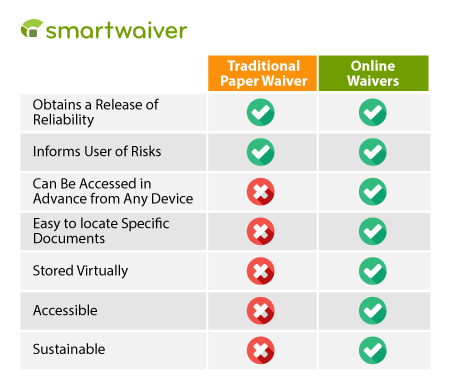Creating Effective Nonprofit Event Waivers: 6 Strategies
Whether you’re hosting an event to kick off your capital campaign or organizing a volunteer appreciation fête, event waivers can help protect your nonprofit from any accidents that occur. Attending almost any event comes with an inherent risk, so you should safeguard your organization from liabilities arising from unfortunate occurrences.
In this guide, we’ll go over six strategies that will help you create effective nonprofit event waivers that help you manage the risks of hosting your event, protect your nonprofit from legal liability, and obtain the informed consent of all attendees. Plus, making an excellent waiver shows event participants that you care about their safety. This transparency goes a long way in building trust with your supporters and volunteers, helping you cultivate lasting relationships.
1. Understand legal requirements.
Before drafting your event waiver, you need to understand the legal requirements for these documents. These documents are legally binding contracts for participants to acknowledge that they accept the risks and responsibilities of attending your event—thus, you need to make sure your language is exact and enforceable.
You’ll need to know your local and national laws regarding event liability, as they can vary from state to state. If you’re working with a fundraising consultant, they can point you in the right direction and help you find a legal professional. Consulting with a lawyer will ensure that your waiver complies with rules and regulations and is legally binding and enforceable.
2. Review similar waivers.
One of the best ways to ensure you’re covering all of your bases is to look at waivers covering the same types of activities or events. Example waivers are easy to find online and can provide a good starting point. Here’s what you should look for in your example waivers:
- Format and structure. How is the example waiver structured? What different elements do they include? How many signatures do they require? This information can guide how you outline your waiver so that it is structured logically.
- Risks covered. Take a look at the risks included in the example waiver to see what you should include. However, do not limit yourself to the exact risks in the example waiver, and always consult your lawyer when drafting your waiver. The important thing is that you’ve disclosed all the risks involved.
- Branding opportunities. Fifty and Fifty recommends that you incorporate your nonprofit’s visual branding into materials including your event waivers. Examine example waivers for how logos, color schemes, letterheads, typefaces, and other branding elements are incorporated to give the forms a unique look.
Although you shouldn’t use these waivers word-for-word, viewing examples helps you get a better idea of what to include, especially if you’ve never used a waiver for your nonprofit before.
3. Gather necessary information.
Aside from mitigating legal liabilities for your nonprofit, your waiver also needs to collect the information you need about your participants in case of an accident. The amount of information you need to collect will depend on your event—for example, if you’re hosting a strenuous outdoor or sports-related activity, you might require more health-related information than if you were hosting a black-tie gala event.
No matter your event, you should at least obtain the following information:
- Name
- Date of birth
- Address
- Contact information
- Emergency contact information
- Health information or allergies
You’ll also want to collect waivers from volunteers. Depending on their responsibilities, your waiver may need to cover more risks than the waivers for attendees. For instance, if you’re hosting a virtual event and have asked volunteers to set up your livestreaming equipment, they could be at risk of having heavy items fall on them while the attendees are not.
4. Disclose all risks that participants could encounter.
We’ve mentioned a few times that part of an effective event waiver is disclosing all the risks that participants might encounter while completing your activity or attending your event. Including all the risks gives participants a better idea of what to expect from your event, allowing them to decide if it’s a good idea for them to attend and what they might need to do to protect themselves.
For instance, let’s say that you run an environmentally-focused nonprofit with a robust volunteer program. As a part of this program, you and your volunteers travel to a nearby nature reserve to spend a day planting trees. In your waiver, you should include risks associated with tree planting and risks related to travel, which may include:
- Bodily injury
- Property loss
- Dehydration
- Inclement weather
- Other natural conditions
To ensure you’ve listed all potential hazards, consider gathering all team members associated with planning and hosting the event to walk through the different activities and any liabilities that may accompany them.
5. Allow participants to sign remotely.
Event day is often hectic for nonprofit staff members and participants alike, and event waivers can quickly slip your mind. To ensure that participants fill out the waivers, offer online waiver forms that they can sign in advance of your event.
Here’s a comparison chart between traditional paper waivers and online waivers, showing you the benefits of choosing online waivers:

Two other advantages of digital waivers are:
- Convenience. Remote signing is far more convenient for your participants and your staff. If you’re hosting a hybrid event, you could include your waiver in the registration process so that in-person participants can sign theirs when they register, whereas virtual participants can skip it.
- Faster check-in. By allowing your participants to sign their waivers remotely, you can spend less time ensuring everyone has signed and more time connecting with supporters!
If getting paper waivers into the right hands before the event seems like a hassle, consider investing in a digital waiver solution. With an electronic waiver, you can send the right forms to your participants, making it easy for them to sign from the comfort of their homes.
6. Keep your waivers on file.
Your waivers don’t just matter on the day of your activity or event, which is why you need an effective and organized storage method for your waivers. Avoid the headache of organizing and storing physical files by purchasing an electronic waiver solution, which is more convenient for you, your staff, and your participants.
Not only will such a tool empower you to offer digital waivers, it will also:
- Eliminate clunky filing cabinets. With all of your waivers stored electronically, you won’t have to worry about carving out extra space in your facility to keep waivers on file. Instead, everything you need will be easily accessible from your computer or tablet.
- Make it easy to locate a waiver. In case of an emergency, you want to be able to find the relevant waiver to access the individual’s identity, emergency contact, and health information. Rather than sifting through stacks of paper forms, you’ll be able to quickly pull up the one you need.
- Send automatic notifications for waiver renewal. Let’s say you require waivers to be renewed every year for strenuous outdoor activities. If this is the case, it might be difficult to keep track of who renewed their waivers and when. Electronic waiver software can notify you right away, ensuring that you never miss a thing.
Plus, finding the right waiver solution doesn’t need to be difficult. There are plenty of comprehensive guides and lists of online waiver options so you can pick one that’s right for your nonprofit—for example, take a look at Smartwaiver’s list of top waiver software providers to get started.
Waivers are crucial for your nonprofit’s events—they ensure that you’re protected from liability, have all the information you need, and can keep your participants informed. Plus, in the long run, effective waivers will build trust between you and your participants, helping you cultivate lasting relationships. Don’t be afraid to consult additional resources such as fundraising books and event planning advice to help you get your event waivers right.
About the Author
 Logan Lewis
Logan Lewis
Logan Lewis is the Content Coordinator at Smartwaiver, the leading digital waiver service trusted by thousands of organizations around the world.





